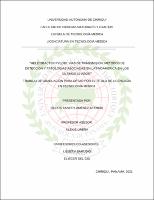Helicobacter Pylori: vías de transmisión, métodos de detección y patologías asociadas en latinoamérica en los últimos 10 años”
Abstract
In Latin America, it is estimated that more than 50% of the population is or has been
infected by the bacterium H. pylori, thus being one of the main causes of
serious gastric pathologies. At the time of completing this thesis project, the
main objectives were based on being able to describe the bacterium H. pylori; their ways of
transmission, its way of acting from the moment it enters the organism; prevalence of infection;
how it can cause various pathologies since it enters the body and compare
the various diagnostic methods.
This study resulted in a higher incidence of infection in people of
adulthood and older because they often contracted the bacteria during childhood and
infection was developing and persisting as they grew; still can't
describe a direct route of transmission but the best known and most prevalent
they are oral-oral, gastro-oral and fecal-oral, with food playing an important role;
comparing the diagnostic tests it was obtained that the CRP is considered as the
best test when wanting to have an accurate diagnosis, although it should be
consider many clinical data of the patient before carrying out any test
diagnostic.
In conclusion, the most affected countries are those that are in the process of
development and there are many conditions that predispose a person to be able to acquire
this bacterium. There are still many more studies to be carried out in order to contribute to knowing
more this bacterium En Latinoamérica, se estima que más del 50% de la población está o ha estado
infectada por la bacteria H. pylori, siendo así una de las principales causas de
patologías gástricas graves. Al momento de realizar este proyecto de tesis, los
objetivos principales se basaron en poder describir a la bacteria H. pylori; sus vías de
trasmisión, su modo de actuar desde que entra al organismo; prevalencia de infección;
como puede ella causar diversas patologías desde que entra al organismo y comparar
los diversos métodos diagnósticos.
Este estudio tuvo como resultado una incidencia de infección mayor en personas de
edad adulta y mayores debido a que solían contraer la bacteria durante la niñez y la
infección se iba desarrollando y persistiendo mientras crecían; aún no se puede
describir una vía directa de transmisión pero las más conocidas y con más prevalencia
son la oral-oral, gastro-oral y fecal-oral, jugando un papel importante los alimentos;
comparando las pruebas diagnóstica se obtuvo que la PCR es considerada como la
mejor prueba al momento de querer tener un diagnóstico certero, aunque se debe de
considerar muchos datos clínicos del paciente antes de realizarse alguna prueba
diagnóstica.
Como conclusión los países más afectados son los que se encuentran en vías de
desarrollo y hay muchas condiciones que predisponen a una persona a poder adquirir
esta bacteria. Aún falta realizar muchos estudios más para así contribuir a conocer
más esta bacteria.

